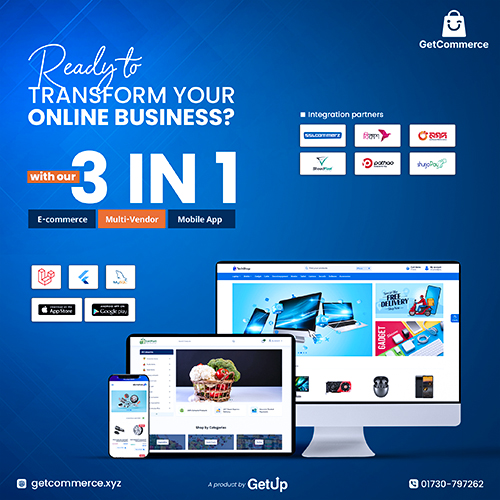A great user experience is essential for success in e-commerce. A flawless and delightful shopping experience can have a profound effect on customer satisfaction, conversion rates, and overall business triumph. Below, you will discover several essential points for elevating the user experience on your e-commerce platform.
1. Intuitive Navigation
One of the most crucial elements of UX is intuitive navigation. Your website must be effortless to navigate, enabling users to locate desired information quickly and seamlessly. To achieve this, it's important to have a clear menu, use descriptive labels, and have an accurate search bar. Using breadcrumbs on your site can help users understand where they are and go back easily.
2. Responsive Design
In this era of booming mobile device usage for online shopping, it is absolutely crucial to have a responsive design. Ensure that your e-commerce website is well optimized for various screen sizes and devices. This will assure a consistently impressive and user-friendly experience on desktops, tablets, and smartphones. By having a site that is mobile-friendly, you can vastly enhance user satisfaction and skyrocket your search engine rankings.
3. Fast Loading Times
Slow-loading pages can be incredibly frustrating for users, leading to a significant increase in bounce rates. However, there are several effective strategies you can implement to optimize your site's performance and ensure a seamless user experience.
One crucial aspect is image compression, as large and uncompressed images can significantly slow down page load times. By compressing your images, you can reduce their file size without compromising their quality, resulting in faster loading speeds.
Additionally, leveraging browser caching can have a significant impact on your site's performance. To reduce load times, configure your server to instruct the user's browser to cache static resources like CSS and JavaScript files. This will minimize the number of HTTP requests.
Furthermore, it is essential to minimize the number of HTTP requests made when a user visits your site. You can do this by combining several CSS and JavaScript files into one file and removing unnecessary code and resources. By doing so, you can optimize load times and create a more seamless browsing experience.
Another effective way is to use a content delivery network (CDN) to share your website's content with servers in different locations. This helps reduce the distance between your users and your server, resulting in faster load times regardless of their location.
Ultimately, aiming for a load time under three seconds should be your goal. This ensures that users remain engaged and have a positive experience while navigating your site. By using these optimization techniques, you can greatly improve your website's performance, decrease bounce rates, and keep your users happy and interested.
4. High-Quality Visuals
Clear and detailed depiction of your products. Utilizing multiple images from various angles, along with incorporating zoom functionality, grants customers an even clearer perspective. Integrating videos or 360-degree views helps users feel more connected to the product, increasing their trust and confidence in making a purchase.
5. Clear Product Descriptions
Compelling product descriptions are crucial - they inform, captivate, and are effortlessly absorbed. Emphasize the prime features, benefits, and detailed specifications, and enhance readability with well-structured bullet points. Ditch the jargon and concentrate on showcasing how the product can effectively address your customer's needs and desires. Integrating authentic customer reviews and ratings will lend valuable social proof, further solidifying your product's credibility.
6. Simplified Checkout Process
A convoluted checkout procedure may result in customers abandoning their carts. To prevent this, simplify your checkout process by reducing the number of steps and only asking for necessary information. Enhance the user experience by providing various payment options, such as popular digital wallets like PayPal and Apple Pay. Additionally, cater to users who are not keen on creating an account by allowing guest checkout.
7. Trust Signals
Establishing trust is absolutely vital when it comes to transforming website visitors into valued customers. It is imperative to prominently showcase various trust signals, including SSL certificates, secure payment icons, and reliable money-back guarantees. Additionally, presenting genuine customer testimonials, positive reviews, and high ratings can serve as compelling social proof. Augmenting trust can also be achieved through implementing crystal-clear and transparent return and privacy policies. Such measures will undoubtedly contribute to building a solid foundation of trust with your potential customers and set the stage for successful conversions.
8. Personalization
It can have a profound impact on the user experience, enhancing your website's relevance to every visitor. By harnessing the power of data and analytics, you have the ability to present personalized product recommendations, curated content, and precisely targeted promotions. Additionally, incorporating personalized emails and follow-ups that align with user behavior undoubtedly elevate engagement levels and skyrocket conversion rates.
9. Effective Call-to-Actions (CTAs)
Clear and compelling calls-to-action (CTAs) are essential in guiding users towards the actions you desire them to take. These actions could include adding items to their cart or signing up for newsletters. To make your CTAs highly effective, utilize action-oriented language that inspires immediate response. Incorporate contrasting colors that catch the eye and make your CTAs truly stand out. Additionally, strategic placement is crucial, as they should be visible and accessible without being too intrusive or overwhelming.
10. User-Friendly Search Functionality
A robust search functionality can significantly improve user experience, particularly for larger e-commerce websites. By incorporating features such as auto-suggestions, filters, and sorting options, users can quickly locate the specific items they desire. When presenting search results, ensure that the information is displayed in a clear and organized manner, showcasing relevant product details.
Conclusion
Enhancing the user experience on your e-commerce site is an ongoing endeavor that requires a deep understanding of your customers' needs and preferences, and the ability to optimize your site accordingly. By prioritizing intuitive navigation, responsive design, fast loading times, high-quality visuals, clear product descriptions, a streamlined checkout process, trust-building signals, personalization, effective calls-to-action, and user-friendly search functionality, you can craft a seamless and delightful shopping experience that fosters customer loyalty. Investing in UX not only elevates customer satisfaction, but also yields higher conversions and ensures long-term business success.







Comments: